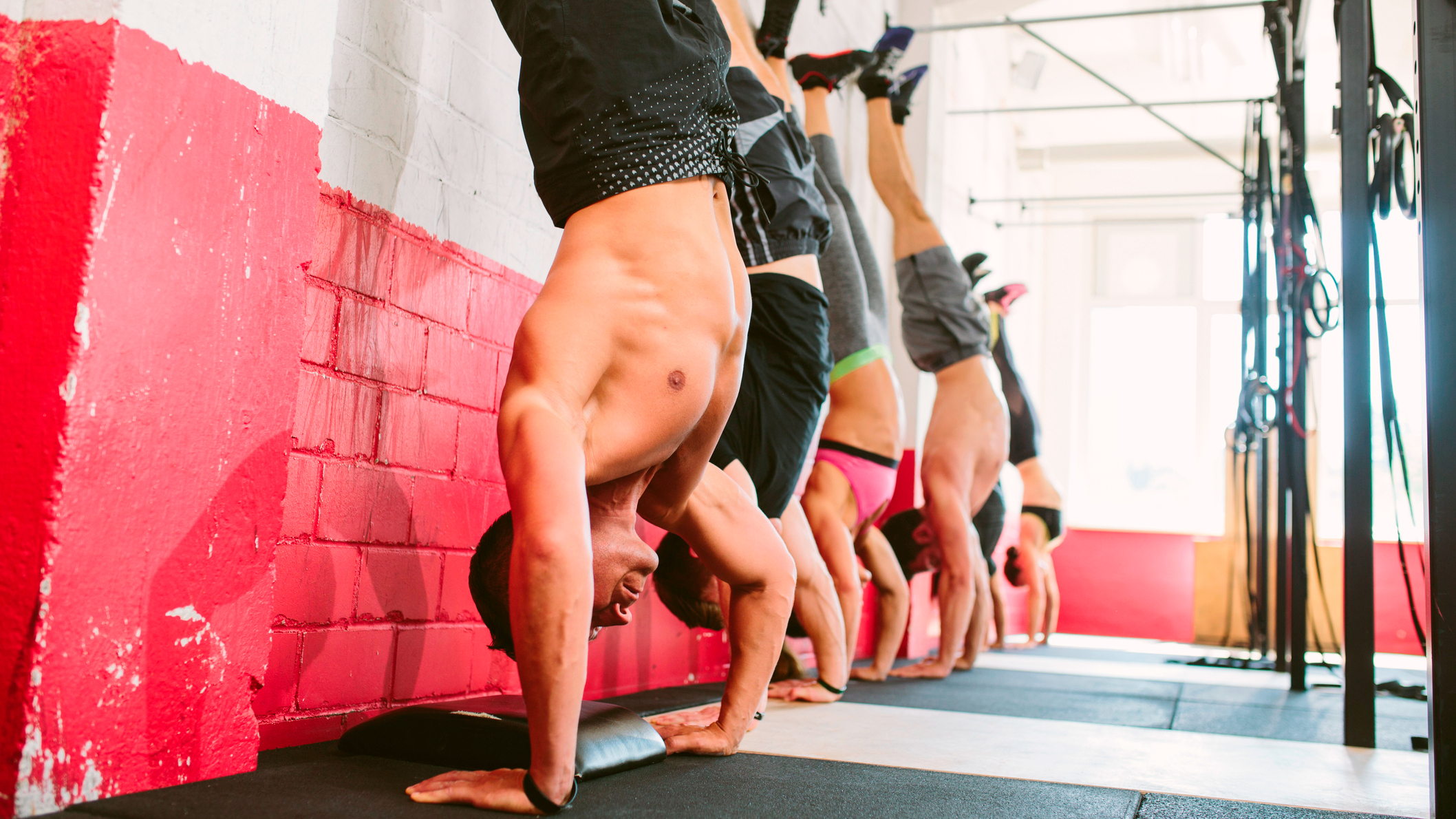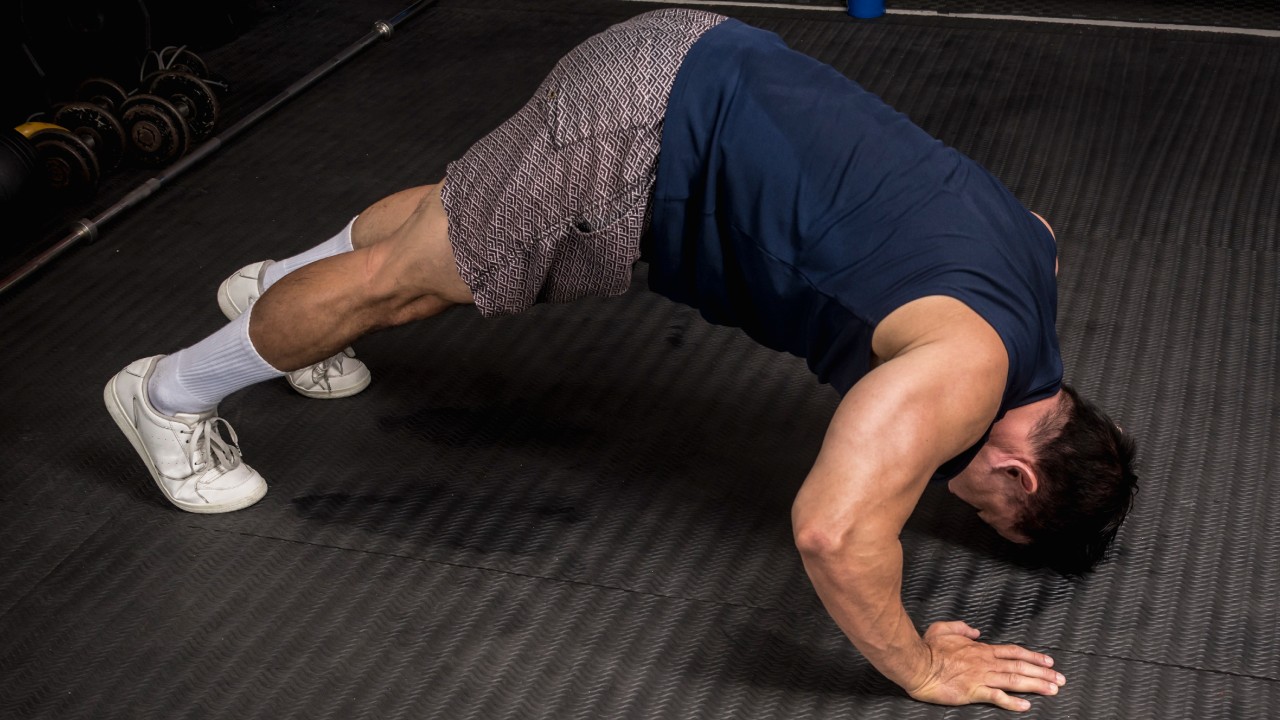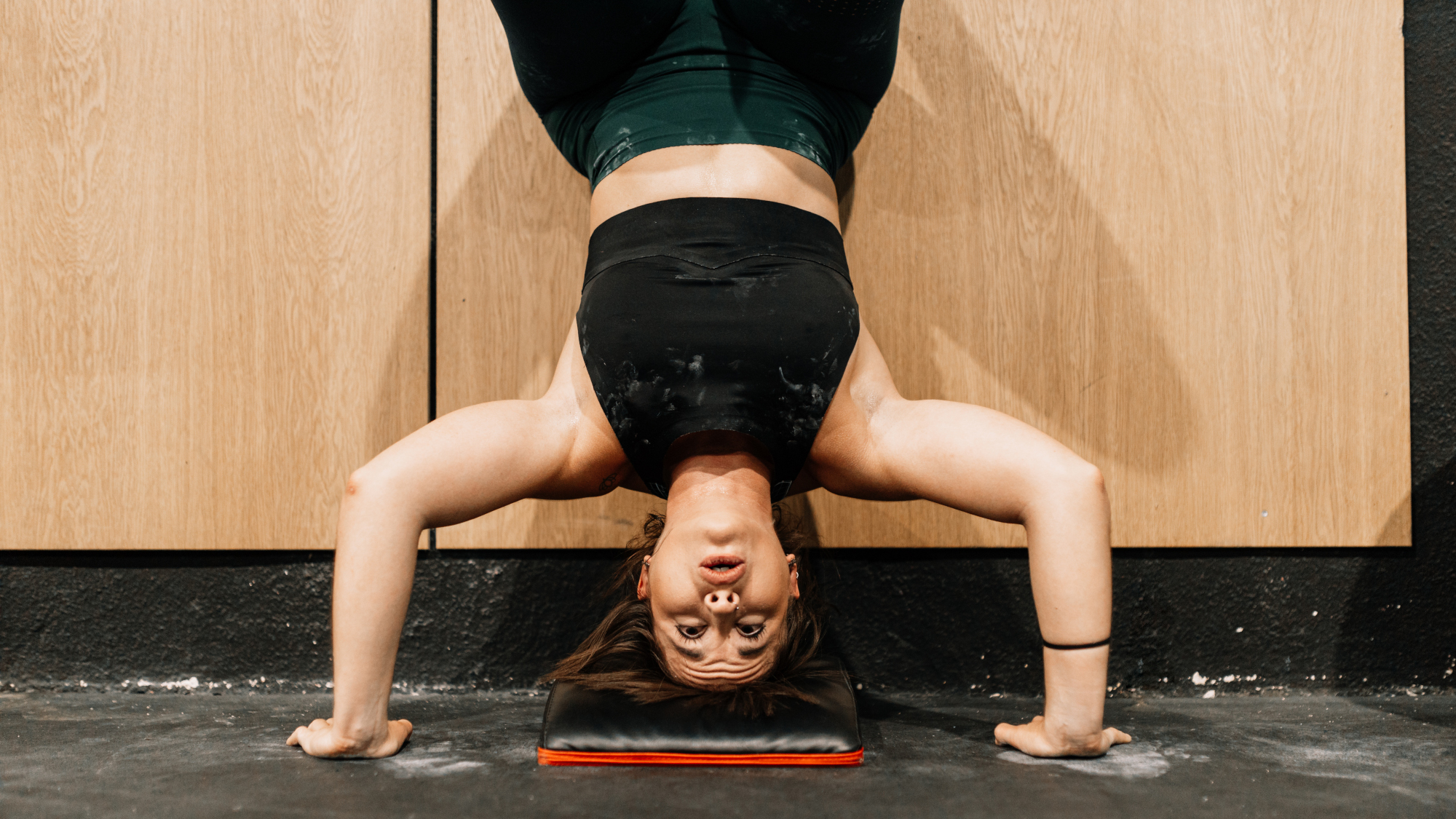
The handstand push-up is an eye-catching gymnastics exercise and the pinnacle of bodyweight shoulder strength. It requires impeccable form, shoulder mobility and balance to execute correctly, but with the right approach, this gravity-defying trick is achievable.
Handstand push-ups are also not just for show. Practicing them can take your core strength, balance and co-ordination to a whole new level, all while giving you an enormous sense of achievement. They’re also one of the best shoulder exercises for developing upper-body strength and drilling functional movement patterns.
To work your way up to a proficient handstand push-up, first you need to be capable of holding a wall-supported handstand for at least one minute. That’s no easy feat so we strongly recommend you work on your handstands with a fitness professional. They will show you how to build up to a handstand and guide you through any strength or mobility work you need to improve your form.
Here, we discuss which muscles the handstand push-up targets, explore its many benefits, highlight some pitfalls to avoid, and outline how to nail this complex movement.
Our guide focuses on strict handstand push-ups, where you keep your body in a straight line throughout, rather than the kipping handstand push-ups commonly seen in CrossFit. The kipping variety, which involves kicking up your legs to generate momentum, is a more explosive move and requires a different training approach.
Which Muscles Does The Handstand Push-up Work?
The handstand push-up is a great example of a compound exercise. It targets your upper body, particularly your shoulder, arm and chest muscles. But to provide stability when upside down, your body also has to engage multiple muscles in your back, core, glutes and thighs.
“It’s especially effective at strengthening the shoulders because it simultaneously targets all three heads of the deltoids, along with several stabilizing muscles, such as the rotator cuff,” says Mitch Raynsford, a certified strength and conditioning coach at digital fitness coaching platform P3RFORM.
Sign up for workout ideas, training advice, reviews of the latest gear and more.
The shoulders take the greatest strain, but the triceps muscles, the pectoralis major and pectoralis minor of the chest, and the spine-stabilizing extensors, trapezius and latissimus dorsi muscles of the back are all targeted too.
“Chest and back engagement is especially important for stabilizing your shoulder joint,” says Raynsford. And your deep core muscles, including the transverse abdominis, rectus abdominis, obliques and even your pelvic floor muscles will all be working overtime to prevent you from swaying to the side, tilting forward or collapsing altogether.
“Your glutes and hamstrings will also be put through their paces too,” says Raynsford. These muscles will be particularly engaged during freestanding handstand push-ups, when the security of a wall to support your legs is taken away.
Handstand Push-Up Benefits
The handstand push-up is a great exercise for building sculpted shoulders and increasing upper-body strength, but its benefits don’t end there.
To start with, you don’t need any advanced equipment. The handstand push-up can be done anywhere, any time—all you need is a wall or a box, and potentially a training buddy to help you get into position safely.
Regular practice promotes proprioception, meaning it helps your body improve the perception of its own position in space, while establishing better communication pathways between your brain and muscles and more efficient muscle engagement. As a result, the handstand push-up does wonders for your balance, co-ordination and core stability.
Handstand Push-Up Risks
Despite the move’s long list of benefits, there are a few potential risks you should bear in mind, especially if you have high blood pressure or are dealing with ailments affecting the ears or eyes.
Practicing this exercise may cause you more harm than good, for example, if you have an ear infection that affects your balance. Having your head upside down may also increase the pressure in your eyeballs, which can be particularly dangerous for people with glaucoma (damage to the optic nerve), according to the American Optometric Association.
The handstand position also carries increased risk for those with high blood pressure and those vulnerable to heart disease, according to Harvard Health. That’s because pumping blood against gravity requires the heart to produce more forceful contractions.
Don Saladino, a celebrity personal trainer and a Lumen ambassador, suggests those with especially poor posture should prioritize improving their mobility or flexibility before launching into a high-risk handstand push-up.
“If someone has poor posture, with a rounded upper back and an inability to externally rotate their shoulders, the only way they're going to be able to get into the position is by overextending their lower back. This can easily lead to an injury,” he says.
Cody Mooney, a former CrossFit Games athlete and the director of performance for the mobility and recovery app pliability, says the risks to your joints are even greater when adding a kipping movement into this exercise, especially if your hips are tight.
That said, if you have enough mobility, stability and upper-body strength, you’ll be able to do it safely. “I've seen intermediate level CrossFitters doing handstand push-ups with great form,” says Mooney. “It’s all about having the right foundations to put yourself in a good position and then build up from there.”
How To Work Up To A Handstand Push-Up

Mastering the handstand push-up requires thorough preparation, dedicated practice and plenty of patience. “It all depends on the individual: Their overhead strength, abilities and previous training history, but also their confidence and mental resilience,” says Raynsford.
Before you launch into it head first, check if your shoulders can sustain the weight of your body. “If you can do three sets of 10 reps of the pike push-up, that’s a good sign you can progress to handstand push-ups,” Raynsford says.
Barbell pressing your bodyweight overhead is another good indicator, so long as you have above-average shoulder mobility to match this impressive feat.
Here Mooney has outlined his three-step plan to build up to your first handstand push-up.
1. Practice the pike
The first step is about learning how to get in and out of the handstand position using a box. Start in a straight-arm plank position, facing away from the box. Push your hips up and put your feet up on the box. Then, gradually walk your hands closer to the box until your torso is vertical, or “as far as you feel you can go comfortably,” says Mooney.
2. Master the kick
“Once you’re comfortable being upside down, focus on the kick,” says Mooney. Now’s a good time to rope in a training partner for support. Start by facing the wall. Put your hands on the floor next to the wall, shoulder-width apart. Keeping your arms locked out and shoulders braced, kick your feet up so your heels rest against the wall. “Really focus on stabilizing your shoulders and think about all the muscles working to hold your position,” Mooney adds.
3. Prime the push
Once you feel confident in a handstand position, you can start working on the push-up. “Don’t shoot for a full rep straight away,” says Mooney. First, get used to the pressure the move exerts on your upper body. “Start by drilling half-range handstand push-ups, and only progress if you have full confidence in your shoulder mobility.”
If in doubt, always consult a physiotherapist or a certified strength and conditioning coach. Raynsford also suggests using a thick padded gym mat or large cushion under your head to help break your fall, and insists you always train with another person present to help if anything goes awry.

How To Do A Handstand Push-up
How To Warm Up For The Handstand Push-up
Warming up is an essential part of any workout, but it carries greater significance for handstand movements. If your body isn’t ready to take the load, you won’t engage your muscles properly, and will put yourself at risk of serious injury.
To prepare properly, include warm-up exercises that mobilize your neck, shoulders, glutes and spine, such as the child’s pose and downward dog moves from yoga. These shoulder warm-up exercises are also well worth running through.
Resistance bands and cable machines can be particularly beneficial too. “These allow you to maintain constant tension throughout an exercise, helping activate all the stabilizing muscles, like the teres minor and teres major of the rotator cuff,” says Mooney.
Handstand Push-Up Form
Stand facing a wall, ideally with a mat in position to provide cushioning. Bend down and place your hands about a foot away from the wall, slightly wider than shoulder-width apart, with your fingers spread. Bracing your shoulders and core, powerfully kick up into a handstand so that your heels rest against the wall.
Once upside down, steady your position by squeezing your glutes. From your wrists to your feet, your body should form one straight line. Carefully bend your elbows to lower the crown of your head toward the floor or mat. Allow your head to lightly touch the floor, then press hard through the heel of your hands to drive back up. Extend your arms fully, breathe, and continue into the next rep.
Mooney says: “A slow descent is one of the best ways to help avoid injury. Rushing on your way down can strain your neck. Instead of relaxing as you lower, take a big breath in to brace your core and help control your descent.”
About Our Experts

Cody Mooney is the director of performance for the mobility and recovery app pliability. Cody started doing CrossFit when he was 15, and became a coach at his local gym at 16. After deciding to pursue a career in CrossFit, he became a two-time CrossFit Games athlete in 2019, and was part of the second fittest team in the world.

Mitch Raynsford is a certified personal trainer, UKSCA-accredited S&C coach, and the lead strength and conditioning coach at digital fitness coaching platform P3RFORM. He holds a MSc degree in Sports Science and Applied Sports Physiology from the University of Brighton. Mitch has worked for Aston Villa Women football club as the lead trainer preparing players for a return to competitive matches, and also took on the role of sports scientist with the senior squad.

Don Saladino has trained celebrities including Ryan Reynolds, John Krasinski and Blake Lively, and has appeared on the cover of Muscle & Fitness magazine twice. He is NASM-certified and opened the New York City gym Drive 495 in 2005.

Anna Gora is a health writer and certified PT with more than a decade’s experience in the fitness industry. She provides online health coaching to people as part of the UK’s Healthier You: NHS Diabetes Prevention Programme and has a master’s degree in Nutrition, Physical Activity & Public Health from the University of Bristol. As well as Coach, Anna also contributes to sister site Fit&Well and science news website Live Science.
